Nestled in the picturesque landscape of northern California, Mount Shasta stands as a silent sentinel, drawing visitors with its imposing stature and enigmatic allure. This dormant volcano, shrouded in mystery and natural beauty, beckons exploration and introspection alike. From its ancient origins to the spiritual significance attributed to it, Mount Shasta holds a wealth of stories and experiences waiting to be uncovered. Whether you seek adventure in its rugged terrain or a deeper connection with nature, this iconic landmark promises a journey filled with surprises and revelations.
Key Takeaways
- Sacred mountain in northern California.
- Formed around 593,000 years ago.
- Home to endangered species.
- Offers diverse outdoor activities.
- Known for spiritual significance and energy vortexes.
Geographical Location
Nestled in the northern part of California, Mount Shasta stands as a prominent stratovolcano in the southern end of the Cascade Range. Its geographical location coordinates are approximately 41.4090° N latitude and 122.1944° W longitude. The mountain is situated in Siskiyou County and is part of the Shasta-Trinity National Forest. Mount Shasta's peak reaches an elevation of 14,179 feet (4,322 meters) above sea level, making it the second-highest peak in the Cascades and the fifth highest in California.
The topography of Mount Shasta is characterized by its massive conical form, with four main overlapping cones that make up its summit. These cones are remnants of earlier volcanic activity and give Mount Shasta its distinctive appearance. The mountain boasts a base diameter of approximately 17 miles (27 km), offering a wide expanse of terrain for outdoor enthusiasts to explore. Glaciers, including Whitney Glacier, Hotlum Glacier, and Bolam Glacier, adorn the slopes of Mount Shasta, adding to its allure and providing opportunities for activities such as mountaineering and ice climbing.
Due to its location in a region known for its volcanic activity, Mount Shasta is closely monitored by the United States Geological Survey (USGS) for any signs of potential volcanic unrest. The topography of the area plays an important role in understanding the geological processes that have shaped Mount Shasta and continue to influence its dynamic landscape.
Formation and Geological Features
Mount Shasta's formation and distinctive geological features are a demonstration of the complex volcanic processes that have shaped this prominent stratovolcano in the southern Cascade Range of California. The geological history of Mount Shasta dates back to around 593,000 years ago when its formation processes began. This stratovolcano is composed of layers of hardened lava, pumice, and ash, showcasing a variety of rock formations that reflect its tumultuous past of volcanic activity.
The mountain rises abruptly from the surrounding terrain, standing at an impressive height of 14,179 feet, making it one of the highest peaks in the Cascade Range. Its symmetrical cone, often capped with snow, adds to its grandeur, attracting climbers and nature enthusiasts from around the world. Mount Shasta's geological features include deep ravines, glaciers, and hot springs, creating unique landscapes that contribute to its status as one of nature's wonders.
Volcanic activity continues to shape Mount Shasta, with the last significant eruption occurring in 1786. Despite its dormant status, the mountain remains an active part of the Cascade volcanic arc, which extends from northern California to British Columbia. This connection to the larger network of mountain ranges highlights Mount Shasta's significance in the study of geological processes and natural formations.
Native American Legends
Embedded within the cultural fabric of the region surrounding Mount Shasta are ancient legends passed down through generations by Native American tribes. These stories form an integral part of the cultural beliefs and traditions of the indigenous people, showcasing their deep connection to the land and the spiritual significance they attribute to Mount Shasta.
| Cultural Beliefs | Storytelling | Mythical Creatures |
|---|---|---|
| The Native American tribes in the area believe that Mount Shasta is a sacred place inhabited by powerful spirits and entities. | These legends are often shared through oral traditions, with storytellers passing down the tales of the mountain from one generation to the next. | According to the folklore, Mount Shasta is home to mythical creatures such as the Llao, a malevolent spirit believed to dwell within the mountain and challenge the forces of good. |
The stories not only serve as a form of entertainment but also hold deeper meanings, reflecting the spiritual connections that the Native American tribes have with the land. Through these myths, the tribes convey their reverence for nature and their understanding of the interconnectedness between the physical and spiritual domains. The legends of Mount Shasta continue to captivate audiences, offering a glimpse into the rich cultural heritage of the region and the profound beliefs held by its indigenous inhabitants.
Biodiversity and Ecosystem
The biodiversity and ecosystem surrounding Mount Shasta exhibit a remarkable array of plant and animal species, showcasing a complex web of interactions and adaptations within this unique natural environment. Mount Shasta's ecosystem is a delicate balance of flora and fauna, each playing an important role in maintaining the overall health and sustainability of the region.
Here are some key points to keep in mind when exploring the biodiversity and ecosystem of Mount Shasta:
- Endangered Species and Conservation: Mount Shasta is home to several endangered species, such as the Siskiyou Mountains Salamander and the Mount Shasta Lilac. Conservation efforts in the area are essential to protect these species from further decline and preserve the delicate balance of the ecosystem.
- Food Chain Dynamics: The food chain in Mount Shasta's ecosystem is intricate and interconnected. From the smallest insects to the largest predators, each organism plays a role in maintaining the flow of energy throughout the ecosystem. Disruptions to the food chain can have far-reaching consequences on the entire ecosystem.
- Habitat Loss: One of the greatest threats to the biodiversity of Mount Shasta is habitat loss. Human activities such as deforestation, development, and pollution have led to the destruction of critical habitats for many plant and animal species. Efforts to protect and restore these habitats are essential to safeguard the rich biodiversity of the region.
Outdoor Activities and Recreation
Numerous outdoor activities and recreational opportunities abound in the diverse natural surroundings of Mount Shasta, offering visitors a multitude of ways to engage with the environment and immerse themselves in the region's picturesque landscapes. Whether you are an outdoor enthusiast, thrill-seeker, or nature lover, Mount Shasta has something to offer for everyone. Below is a table outlining some of the top outdoor activities and recreation options available at Mount Shasta:
| Outdoor Activities | Description |
|---|---|
| Camping tips, gear | – Choose a campsite with proximity to water sources and stunning views. – Essential gear includes a tent, sleeping bag, cooking supplies, and appropriate clothing. |
| Adventure sports | – Participate in guided mountaineering expeditions to conquer the challenging peaks. – Engage in rock climbing, skiing, snowboarding, and mountain biking for an adrenaline-pumping experience. |
| Excursions | – Join organized hiking trips to explore the diverse trails and witness the breathtaking vistas. – Take a guided fishing tour in the pristine waters surrounding Mount Shasta. |
With these varied options, visitors can indulge in camping under the starry skies, participate in thrilling adventure sports, or join guided excursions to explore the natural wonders of Mount Shasta. Make sure to pack the necessary camping gear and prepare for an exhilarating outdoor adventure in this enchanting region.
Spiritual Significance
In exploring Mount Shasta's spiritual significance, one finds a convergence of ancient legends, metaphysical beliefs, and modern-day spiritual practices interwoven with the mountain's mystique and allure. Mount Shasta is renowned for its spiritual energy, drawing individuals from around the world seeking enlightenment, healing, and transformation.
Here are three key aspects that contribute to Mount Shasta's spiritual significance:
- Meditation Retreats: Mount Shasta serves as a haven for meditation practitioners seeking inner peace and self-discovery. Numerous retreat centers and workshops offer guided meditation sessions, silent retreats, and spiritual teachings amidst the serene and powerful energies of the mountain.
- Energy Vortexes: Believed to be a focal point of cosmic energy, Mount Shasta is said to contain various energy vortexes that amplify spiritual experiences and personal growth. These vortexes are thought to facilitate deep healing, heightened intuition, and spiritual awakening for those who are receptive to their energy.
- Metaphysical Beliefs: Mount Shasta is steeped in metaphysical lore, with legends of Lemurians, ancient beings of higher consciousness, said to reside within the mountain. Many spiritual seekers are drawn to Mount Shasta to connect with these ethereal beings and tap into the mystical energies that permeate the region.
The spiritual significance of Mount Shasta transcends its physical beauty, offering a profound opportunity for individuals to explore their inner selves and connect with the divine energies that are believed to abound in this sacred space.
Climbing and Hiking Routes
Exploring Mount Shasta's diverse landscape reveals a network of climbing and hiking routes that cater to adventurers of varying skill levels and interests. When setting out on these journeys, ensuring trail safety and having the right equipment are essential. It is vital to check weather conditions before starting out and obtain any necessary permits to access certain areas legally.
To better understand the climbing and hiking routes available on Mount Shasta, refer to the table below:
| Route Name | Difficulty Level | Trail Safety Tips |
|---|---|---|
| Avalanche Gulch | Intermediate | – Check for avalanche warnings |
| – Carry ice axe and crampons | ||
| Clear Creek | Advanced | – Be cautious of loose rocks and steep terrain |
| – Use a helmet for added protection | ||
| Panther Meadows Loop | Easy | – Stay on designated trails |
| – Bring plenty of water and snacks for the hike | ||
| Green Butte Ridge | Expert | – Familiarize yourself with the route before attempting |
| – Have proper climbing gear and ropes for technical sections |
These routes offer a range of challenges and experiences for hikers and climbers alike. By following trail safety guidelines, being prepared with the right equipment, and respecting the mountain's conditions, adventurers can enjoy the beauty and freedom Mount Shasta has to offer.
Nearby Attractions and Towns
Adjacent to Mount Shasta lies a plethora of alluring attractions and quaint towns waiting to be explored. Visitors to the region can immerse themselves in the vibrant local culture by indulging in the following experiences:
- Local Cuisine and Events: The towns near Mount Shasta boast a rich culinary scene that showcases the best of local produce and flavors. From farm-to-table restaurants serving up organic dishes to charming cafes offering freshly brewed coffee, food enthusiasts will find a diverse array of dining options to tantalize their taste buds. Additionally, the area hosts a variety of events throughout the year, including food festivals, music concerts, and art exhibitions, providing ample opportunities for cultural enrichment and community engagement.
- Artisan Shops and Markets: Artisan shops and markets in the vicinity of Mount Shasta offer a treasure trove of handcrafted goods, unique souvenirs, and locally made products. Visitors can browse through galleries featuring works by talented artists, shop for one-of-a-kind jewelry pieces, or explore boutiques filled with handmade crafts. The markets in the area are perfect for picking up fresh produce, organic goods, and artisanal treats, allowing visitors to savor the flavors of the region and support local businesses.
Exploring the nearby attractions and towns around Mount Shasta provides a holistic experience that combines culinary delights, artistic endeavors, and community celebrations, making it a must-visit destination for travelers seeking a taste of freedom and adventure.
Conservation Efforts and Sustainability
Efforts in conservation and sustainability surrounding Mount Shasta are vital to preserving the ecological balance and safeguarding the natural beauty of the region. Community involvement plays an essential role in these initiatives, with local organizations and residents actively participating in conservation projects.
One of the key focuses of sustainability efforts in the Mount Shasta area is the promotion of renewable energy initiatives. Renewable energy plays a significant role in reducing the carbon footprint of the region and mitigating the impact of climate change on Mount Shasta's ecosystem. Initiatives such as the installation of solar panels, wind turbines, and geothermal energy systems contribute to a more sustainable future for the area. These efforts not only help in preserving the natural habitats and biodiversity of Mount Shasta but also pave the way for a greener and more environmentally conscious community.
Moreover, community involvement in conservation efforts fosters a sense of responsibility and stewardship among residents and visitors alike. Through education, outreach programs, and hands-on conservation activities, individuals are encouraged to take an active role in protecting the fragile ecosystem surrounding Mount Shasta. By working together towards common sustainability goals, the community safeguards that the region's natural resources are preserved for future generations to enjoy.
Frequently Asked Questions
Are There Any Reported UFO Sightings Around Mount Shasta?
There have been numerous reports and accounts of UFO sightings worldwide, with some claiming to have had alien encounters. These claims often spark conspiracy theories and discussions of government cover-ups.
Paranormal phenomena related to unidentified flying objects continue to be a topic of interest and debate among believers and skeptics alike. The exploration of such occurrences remains a complex and intriguing subject that warrants further scientific investigation and analysis.
What Is the Significance of Crystal Caves Near Mount Shasta?
Exploring caves filled with crystal formations is significant for several reasons. These unique underground environments offer a glimpse into the Earth's geological history. They provide a rich source of crystals used in alternative healing practices like crystal healing. The intricate patterns and vibrant colors of these crystals not only fascinate explorers but also serve as tools for promoting well-being and balance in individuals seeking a connection with the earth's energy.
Can You See the Pacific Ocean From the Summit of Mount Shasta?
Mountain climbers ascending to high altitudes often seek exceptional visibility from summits. The ability to view distant landmarks, such as oceans, enhances the experience.
Factors affecting visibility include atmospheric conditions, such as fog or haze, and the position of the sun, influencing visibility during sunrise.
Weather conditions play a vital role in determining how far one can see from a summit, impacting the panoramic view available to climbers.
Are There Any Unique Plant Species Found Only on Mount Shasta?
In the world of botanical diversity, the charm of rare flora lies in the discovery of endemic species, flourishing in unique habitats. These ecosystems host a plethora of plant life, each evolved to thrive in their specific environment.
Exploring the world of unique vegetation reveals a tapestry of biodiversity that captivates the senses and ignites a passion for conservation. The presence of endemic species showcases the intricate balance of nature and the delicate dance of evolution.
Is There a Specific Time of Year to Witness Lenticular Clouds Near Mount Shasta?
Lenticular clouds often form near mountainous regions due to the unique atmospheric conditions created by the topography. The best time to witness these clouds is during stable atmospheric conditions with strong winds aloft.
Ideal weather conditions include clear skies with a steady wind flow perpendicular to the mountain range. To capture stunning photographs of lenticular clouds, seek out high vantage points or open areas with unobstructed views of the sky.
Conclusion
To sum up, Mount Shasta stands tall like a guardian overlooking the northern California landscape, offering a glimpse into its rich geological history and spiritual significance.
With its diverse ecosystems, outdoor activities, and sacred aura, this majestic peak continues to captivate visitors and locals alike.
As efforts towards conservation and sustainability are increasingly prioritized, Mount Shasta remains a beacon of natural beauty and cultural heritage for generations to come.


